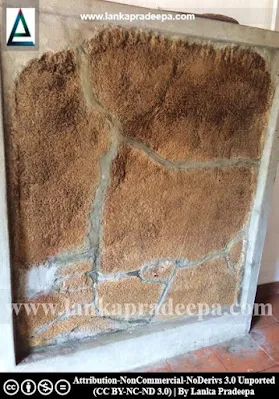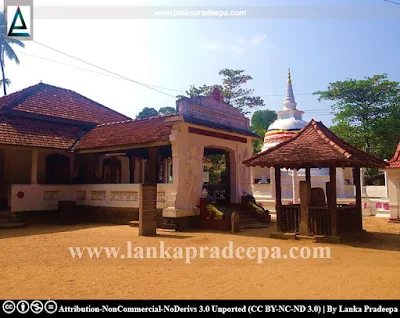
The Kingdom of Kotte (Sinhala: කෝට්ටේ රාජධානිය; Tamil: கோட்டை இராச்சியம்) was the fifth kingdom in Sri Lanka that flourished on the island from the 15th to the end of the 16th century (from 1412 A.D. to 1597 A.D.). It is considered the last native sovereign that unified the entire island under one rule.
History
The Sinhalese Kingdom which was first established in Anuradhapura in the 3rd century B.C. moved to Polonnaruwa during the 11th century A.D. due to foreign invasions mainly flooding from neighbouring India. It was then gradually moved to the southwest part of the country, starting from Dambadeniya to Gampola. After the shift from Gampola, Kotte became the capital city of the Sinhalese Kingdom in the 15th century A.D.
Details about the ancient Kotte Kingdom are found in several old documents such as Nikaya Sangrahaya (1396 A.D.), Saddharmaratnakaraya, Alakeshvara Yuddhaya, Rajavaliya as well as in the descriptions by Couto (1552-1616 A.D.), Ribeiro (1685 A.D.), Queyroz (1688 A.D.) and Valentijn [(1722 A.D.) Fonseka, 2010].
Details about the ancient Kotte Kingdom are found in several old documents such as Nikaya Sangrahaya (1396 A.D.), Saddharmaratnakaraya, Alakeshvara Yuddhaya, Rajavaliya as well as in the descriptions by Couto (1552-1616 A.D.), Ribeiro (1685 A.D.), Queyroz (1688 A.D.) and Valentijn [(1722 A.D.) Fonseka, 2010].
Construction of Kotte Fortress
According to Nikaya Sangrahaya, the initial step to make Kotte a fortified city was taken by Alagakkonara (Nissanka Alakesvara) during the reign of King Vikramabahu IV (1360-1373 A.D.) of Gampola (Fonseka, 2010; Somaratna, 1969). It is said that this fort was built as a garrison town to resist the tax collectors who had been appointed by the rulers of Jaffna. The political instability and power struggle that occurred at the end of the 14th century resulted in the giving up of Gampola and the ruling body was then moved to Kotte, the newly established frontier fort. However, Kotte became an official kingdom after the anointing of King Parakramabahu VI (1412-1467 A.D.) as the King of Jayawardanapura (Wijewardana et al., 2011).
King Parakramabahu VI and the conquest of Jaffna
King Parakramabahu VI developed this garrison town into a fortified capital city. In addition to the fortification, the king built a three-storied Temple of Tooth Relic (for the Tooth Relic of the Buddha), and a five-storied palace for himself, but no traces of these two edifices are found today (Fonseka, 2010; Wijewardana et al., 2011) However, the fortification of Parakramabahu VI in Kabok (laterite) stones is still visible at several places in the area.
Sapumal Kumaraya, an adopted son of King Parakramabahu VI, attacked Jaffna (Yapa Patuna) and brought it under the control of the Kotte Kingdom. Therefore, the entire island was unified under one canopy during the reign of Parakramabahu VI for the first time after the reign of King Parakramabahu I the Great [(1153-1186 A.D.) Somaratna, 1969; Wijewardana et al., 2011].
Simhala Peraliya
After the demise of King Parakramabahu VI, the throne of the Kotte Kingdom was given to Prince Jayabahu, the son of Ulakudaya Deviya [(the daughter of King Parakramabahu VI) Suraweera, 1997]. After hearing this coronation, Sapumal Kumaraya who was at the time at Yapa Patuna came to Kotte and usurped the throne and became the king of Kotte under the name Bhuvanekabahu VI [(1469-1480 A.D.) Suraweera, 1997]. However, this incident caused to make an insurrection among the Sinhalese people in the kingdom. Details on the insurrection against King Bhuvanekabahu VI are found in some chronicles such as Rajavaliya and in lithic inscriptions including the Dedigama Slab Inscription.
Arrival of Portuguese
Portuguese, the first European invaders of the island, arrived in Sri Lanka in 1505, during the reign of King Vira Parakramabahu VIII [(1490-1509 A.D.) Jayasuriya, 2016].
Vijayaba Kollaya
An uprising popularly known as Vijayaba Kollaya occurred in 1521, against King Vijayabahu VI (1509-1521 A.D.) resulting in the division of the Kotte Kingdom into three parts (Somaratna, 1969; Wijewardana et al., 2011). The three sons of Vijayabahu VI mutinied against their father and divided the kingdom among themselves. The elder son, Buvanekabahu VII ruled the Kotte as the chief sovereign while Mayadunne ruled Sitawaka, and Pararajasinha (or Raigam Bandara) ruled Raigama.
The demise of the kingdom
The political stability of the Kotte Kingdom started to further deteriorate when Prince Dharmapala (the son of King Buvanekabahu VII’s daughter) became the ruler of the country. By this period, the Portuguese were engaging in commercial trading. In 1565, Prince Dharmapala had to abandon the capital of Kotte due to frequent attacks from the Sitawaka Kingdom led by Mayadunne and his son Rajasinghe I (Wijewardana et al., 2011). The prince who had been baptized as a Catholic by the Portuguese was able to get the assistance of the Portuguese and lived in Colombo under their protection. In 1597 Dharmapala gifted the Kotte Kingdom to the Portuguese throne marking the end of the kingdom that had existed for nearly 200 years.
Rulers of the Kotte Kingdom
Parakramabahu VI (1412-1467 A.D.) Jayabahu II (1467-1469 A.D.)Buvanekabahu VI (1469-1480 A.D.) Panditha Parakramabahu VII (1480-1490 A.D.)
Vira Parakramabahu VIII (1490-1509 A.D.) Dharma Parakramabahu IX [(controversial) Rohanadeera, 1996]
Vijayabahu VI (1509-1521 A.D.) Buvanekabahu VII (1521-1550 A.D.)
Prince Dharmapala (1550-1597 A.D.)
Inscriptions
Several inscriptions (including copper plates and Sannasas) belonging to the rulers of the Kotte period have been recorded by scholars (Rohanadeera, 2007).
King Parakramabahu VI
# Dondra Inscription (1429 A.D.)
# Pepiliyana Sannasas (1431/32/59 A.D.)
# Naimmana Tamil Inscription (1435 A.D.)
# Munneswaram Inscription (1453 A.D.)
# Saman Devalaya Inscription (1454 A.D.)
# Pepiliyana Inscriptions (1454/59 A.D.)
# Aramanapola Sannasas (1459/60 A.D.)
# Madawala Rock Inscription (1461 A.D.)
Senasammata Vikramabahu (a ruler in Kandy: 1469-1511 A.D.)
# Gadaladeniya Inscription (1471 A.D.)
# Aluthnuwara Devalaya Slab Inscription (between 1472-1474 A.D.)
# Vannipola Sannasa (1484 A.D.)
King Bhuvanekabahu VI
# Dedigama Slab Inscription (1478 A.D.)
# Arankele Sannasa (1479 A.D.)
# Crocodile Charm Inscription (between 1469-1474 A.D.)
King Vira Parakramabhu VIII
# Oruwala Sannasa (1492 A.D.)
# Gadaladeniya Viharaya Inscription (1494 A.D.)
# Kudumirissa Viharaya Rock Inscription (1498 A.D.)
# Keragala Viharaya Slab Inscription (1501 A.D.)
# Kelani Viharaya Slab Inscription (1509 A.D.)
Notable literary works of the Kotte period
Bhakthi Shathakaya Buduguna Alankaraya Elu Attanagalu Vamsaya
Elu-silo Shathakaya Gira Sandeshaya Guttila Kavya
Kaw Lakunu Minimal Kawyashekaraya Kokila Sandeshaya
Kuweni Asna Loweda Sangarawa Panchikapradeepaya
Parewi Sandeshaya Perakumba Siritha Purana Namawaliya
Ruwanmala Saddharmaratnakaraya Selalihini Sandeshaya
Vaidya Chinthamani Yogaratnakarakaya
Presently, only a few places in the area are reminiscent of the old glory of the Kotte Kingdom.
Alakeshwara Archaeological Site Ananda Sastralaya Ruins
Diyawanna Oya Gal Ambalama
Kotte Raja Maha Viharaya Perakumba Pirivena
Vehera Kanda Kotte Fortress
King Vijayabahu VI
# Devinuwara Slab Inscription (1513 A.D.)
# Kudagama Slab Inscription (1515 A.D.)
# Veragama Sannasa (1516 A.D.)
# Colombo National Museum Tamil Inscription (1517 A.D.)
# Kadirana Copper Plate Grant (1517 A.D.)
# Keragala Viharaya Inscription (1520 A.D.)# Devinuwara Devalaya Sannasa (1520 A.D.)
Literature
The Sinhalese literature was at the peak of its development during the Kotte period. Many important literary works in Sinhala, Pali, Sanskrit, and Tamil were written during this period by well-known Buddhist and Hindu scholars such as Thotagamuwe Sri Rahula Thera, Veedagama Maithri Thera, Keragala Wanarathana Thera, Ramachandra Bharathi, and Thannuru Tuneiar. The teaching of Tripitakaya and Buddhism were the main subjects in Kotte literature while poetry, dancing, and astrology were among the other subjects. Keragala Padmavathi, Veedagama Siri Ganananda, Totagamuwe Vijayaba, Pepiliyana Sunetradevi, and Devinuwara Thilaka Pirivena were several prominent teaching institutions that engaged in spreading literacy to the entire country.
Notable literary works of the Kotte period
Bhakthi Shathakaya Buduguna Alankaraya Elu Attanagalu Vamsaya
Elu-silo Shathakaya Gira Sandeshaya Guttila Kavya
Kaw Lakunu Minimal Kawyashekaraya Kokila Sandeshaya
Kuweni Asna Loweda Sangarawa Panchikapradeepaya
Parewi Sandeshaya Perakumba Siritha Purana Namawaliya
Ruwanmala Saddharmaratnakaraya Selalihini Sandeshaya
Vaidya Chinthamani Yogaratnakarakaya
Coins
Thamba-Massa, Silver Angutu-Massa, and Panama were among the main coins circulated during the Kotte period. Other contemporary coins used during this period include Setu and Pagodi coins.
Thamba-Massa (Copper coin of specific weight) - This is a coin minted by King Parakramabahu VI (c.1412-1467 A.D.) following a similar pattern to the Thamba-Massa coin used during the Polonnaruwa (1017-1232 A.D.) and Dambadeniya (1220-1345 A.D.) periods. These coins can be distinguished from early Massa coins by the presence of a seated lion together with the standing figure on the obverse. On the reverse of the coin is a seated man with the legend "Sri Parakramabahu" (the name has been written in Nagari characters). The coins have been minted by pouring molten copper into round clay moulds.
Panama - A valuable coin used during the 14th century A.D. Silver Panama coins were circulated between the period 1454 to 1506 and subsequently replaced by the gold Panama coins.
Silver Angutu-Massa - Circulated since the 16th century A.D. Silver Angutu-Massa was also known by the names bent-silver, Masu-angutu, and Koku-massa. The coin has been made by bending a 4-inch long silver wire of a specific diameter into a hook-shaped structure.
Historical sites situated within the present Kotte Municipality
Kotte was the capital of Sri Lanka from 1412 to 1565 A.D. (Fonseka, 2010). Since it existed for nearly 150 years as the capital of the country, a significant amount of preserved ruins of this ancient kingdom can be expected. However, the rapid development and land occupation that was taken place in recent history in this area has caused massive destruction of the ruins of this ancient kingdom.
Presently, only a few places in the area are reminiscent of the old glory of the Kotte Kingdom.
Alakeshwara Archaeological Site Ananda Sastralaya Ruins
Diyawanna Oya Gal Ambalama
Kotte Raja Maha Viharaya Perakumba Pirivena
Vehera Kanda Kotte Fortress
References
1) Fonseka, P., 2010. The ancient city of Kōṭṭe and its fortification. Journal of the Royal Asiatic Society of Sri Lanka, 56, pp.57-117.
2) Jayasuriya, E., 2016. A guide to the Cultural Triangle of Sri Lanka. Central Cultural Fund. ISBN: 978-955-613-312-7. p.16.
2) Jayasuriya, E., 2016. A guide to the Cultural Triangle of Sri Lanka. Central Cultural Fund. ISBN: 978-955-613-312-7. p.16.
3) Rohanadeera, M., 1996. Dharma Parakramabahu IX-The Fake King of Ceylon
Inflated by Portuguese Historians-A Historiographical Perspective.
Vidyodaya J. Soc. Sc., Vol. 7. 1 & 2. pp.13-45.
4) Rohanadeera, M.,
2007. Archaeological Survey of Ceylon: Inscriptions of Ceylon. Vol.
VIII. Department of Archaeology. ISBN: 978-955-91-59-64-3. pp.3-118.
5) Somaratna, G.P.V., 1969. Political history of the Kingdom of Kotte (c. AD 1400-1521) (Doctoral dissertation, SOAS University of London). pp.79-85,147-188, 456-460.
6) Suraweera, A. V., 1997. Rajavaliya: A critical edition with an introduction (In Sinhala). Educational Publications Department. pp.85-86, 90, 219-220.
7) Wijewardana, A., Thilakawardana, A. E. L., Priyangani, S., 2011. Aithihasika Kotte (In Sinhala). Department of Archaeology (Sri Lanka). ISBN: 978-955-9159-69-8. pp.1-5.
5) Somaratna, G.P.V., 1969. Political history of the Kingdom of Kotte (c. AD 1400-1521) (Doctoral dissertation, SOAS University of London). pp.79-85,147-188, 456-460.
6) Suraweera, A. V., 1997. Rajavaliya: A critical edition with an introduction (In Sinhala). Educational Publications Department. pp.85-86, 90, 219-220.
7) Wijewardana, A., Thilakawardana, A. E. L., Priyangani, S., 2011. Aithihasika Kotte (In Sinhala). Department of Archaeology (Sri Lanka). ISBN: 978-955-9159-69-8. pp.1-5.
This page was last updated on 18 February 2023







